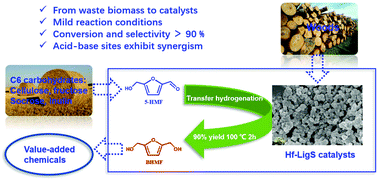Sustainable hydrothermal self-assembly of hafnium–lignosulfonate nanohybrids for highly efficient reductive upgrading of 5-hydroxymethylfurfural†
Abstract
The research for highly selective catalytic transfer hydrogenation (CTH) of 5-hydroxymethylfurfural (5-HMF) into 2,5-bis(hydroxymethyl)furan (BHMF) is an extremely important pathway for biomass valorization. Herein, we use lignosulfonate, a waste by-product from the paper industry, as a building block to coordinate with different metal ions (Hf4+, Zr4+, Fe3+, Al3+, Zn2+) and thus a series of inorganic-biopolymer hybrids (M–LigS) were prepared by a hydrothermal self-assembly method. The resulting Hf–LigS hybrid with strong Lewis acid–base couple sites and moderate Brønsted acidic sites from the inherent sulfonic groups in LigS exhibited the best catalytic activity for CTH of 5-HMF with 2-propanol (2-PrOH) in high yields (90%) under mild reaction conditions (100 °C in 2 h). This robust bifunctional acid–base Hf–LigS is also demonstrated to be effective in one-step reductive etherification of 5-HMF to 5-[(1-methylethoxy)methyl]-2-furanmethanol (MEFA), a potential biomass-derived fuel additive, with 95% yield. Kinetic studies revealed that the activation energy for CTH of 5-HMF was 62.25 kJ mol−1, accounting for the high reaction rate. Isotopic labelling experiments demonstrated that intermolecular hydrogen transfer from the α-C of 2-PrOH to the α-C of 5-HMF was the dominant reaction pathway and the direct hydride transfer on acid–base sites was the rate-determining step. Due to the strong interactions between Hf4+ and phenolic hydroxyl groups, Hf–LigS was highly stable and could be reused without a significant decline in activity.



 Please wait while we load your content...
Please wait while we load your content...